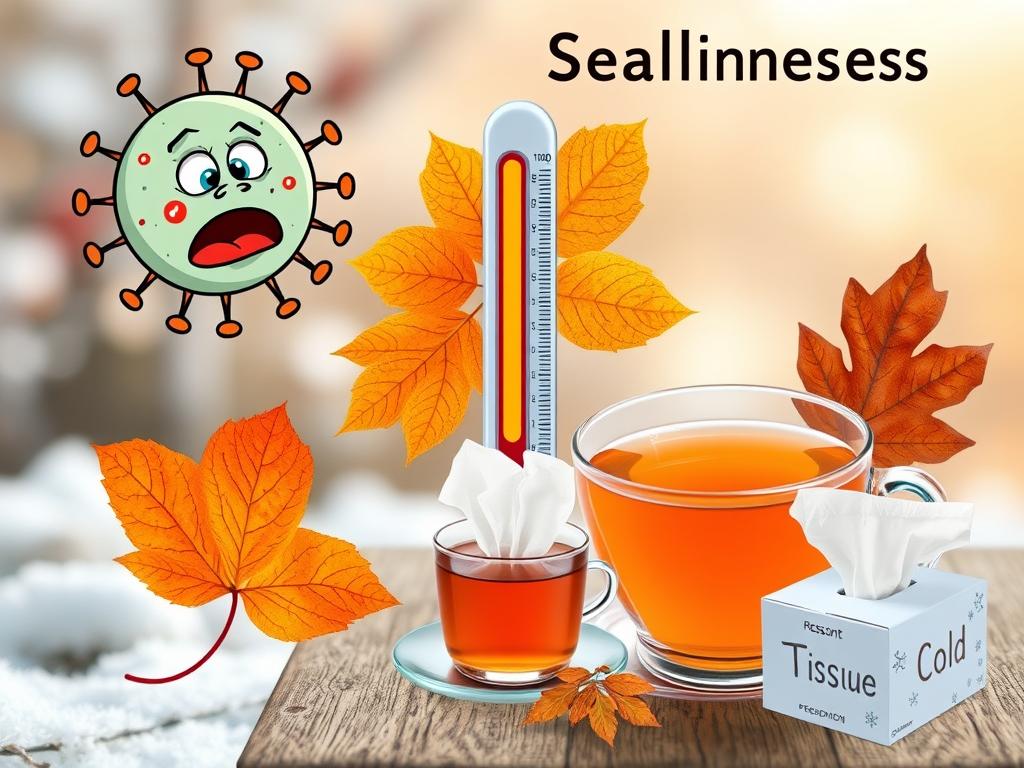Did you know that approximately 5% to 20% of the U.S. population gets the flu each year? This statistic underscores the need for seasonal illnesses prevention strategies, especially during flu season. With the potential for severe symptoms and complications, understanding how to protect yourself is vital to staying healthy during seasons when these issues peak.
Awareness is the first step in combating seasonal illnesses. Recognizing early flu symptoms such as fever, cough, and body aches can empower individuals to respond swiftly and seek appropriate care. High-risk groups, including young children, pregnant individuals, and those over 65, must be particularly vigilant as they are more susceptible to severe complications. Additionally, flu vaccines are not only a proactive measure but are also essential for reducing the risk of hospitalization and death associated with flu-related illnesses.
Furthermore, embracing good hygiene practices, such as regular handwashing and respiratory etiquette, plays a crucial role in minimizing the spread of viruses. This article will delve into effective precautions for flu season, aiming to equip you with the knowledge necessary to maintain your health and well-being despite the seasonal challenges ahead. For comprehensive guidance on recognizing flu symptoms early, visit this resource.
Key Takeaways
- Understanding seasonal illnesses is crucial for effective prevention.
- Flu vaccinations are recommended for everyone aged 6 months and older.
- Awareness of common symptoms can prompt timely medical intervention.
- Maintaining good hygiene practices reduces the spread of viruses.
- Staying informed about vaccines and health guidelines can protect high-risk individuals.
- Adopting a healthy lifestyle can naturally boost your immune system.
Understand Seasonal Illnesses and Their Impact
Recognizing the landscape of common seasonal illnesses can empower individuals to take proactive steps for their health. Each year, various illnesses, including the flu, common colds, and respiratory syncytial virus (RSV), tend to spike, particularly during colder months. Understanding these illnesses is essential for flu and cold awareness and timely intervention.
Common Types of Seasonal Illnesses
Various viruses circulate seasonally, with the following being quite prevalent:
- Influenza: Often causes fever, cough, body aches, and fatigue.
- Common Colds: Symptoms include stuffy or runny nose, sneezing, and fatigue.
- RSV: Primarily affects children and older adults, leading to severe respiratory issues.
- Croup: Affects young children with a characteristic barking cough and difficulty breathing.
The Importance of Awareness
Staying informed about seasonal illnesses is vital. Awareness aids in recognizing illness symptoms early. For instance, infants born prematurely and older adults are at a higher risk of severe illness from these viruses. Awareness allows for timely medical intervention, which can be crucial for those at risk.
Symptoms to Watch For
Being able to identify symptoms significantly helps in managing seasonal illnesses. Common symptoms may include:
| Illness | Common Symptoms |
|---|---|
| Influenza | Fever, chills, cough, sore throat, body aches, fatigue |
| Common Cold | Runny or stuffy nose, sneezing, fatigue |
| RSV | Low-grade fever, dehydration, severe congestion, coughing |
| Croup | Barking cough, difficulty breathing, fever |

Boost Your Immune System Naturally
Enhancing your immune system is essential for maintaining overall health, especially during flu season. Incorporating certain lifestyle choices can significantly contribute to boosting immunity naturally. One of the most effective strategies is to focus on nutrient-rich foods for health. These foods provide the essential vitamins and minerals needed for robust immune function.
Nutrient-Rich Foods to Include
To support your immune system, consider adding the following foods to your diet:
- Fruits and Vegetables: Aim for a colorful array, especially those rich in vitamins C and E, which help fortify immunity.
- Nuts and Seeds: Sources of zinc and vitamin E, these can enhance immune responses.
- Whole Grains: They provide necessary B vitamins, including vitamin B-12, which is vital for energy and overall health.
Such nutrient-rich foods for health not only support your immune system but also contribute to your overall well-being.
The Role of Exercise
The importance of exercise cannot be underestimated when it comes to immune support. Regular physical activity fosters better circulation, enabling immune cells to move more freely throughout the body. In addition, exercise can help reduce stress hormones, which, when elevated, weaken the immune system. Engaging in at least 30 minutes of moderate activity most days is an effective way to maintain your health.
Importance of Sleep and Hydration
Sleep and hydration play critical roles in boosting immunity naturally. Adequate sleep ranges from 7 to 9 hours for adults, while children may require more. Quality sleep helps regulate the body’s immune responses, allowing it to function optimally. Furthermore, staying hydrated is equally important; aim for at least eight glasses of water daily to support every system in your body, including immune function.

Prioritizing sleep, hydration, and exercise not only contributes to a stronger immune system but also fosters a healthier lifestyle overall. By enriching your diet with nutrient-rich foods and staying active, the body can better equip itself to fend off seasonal illnesses.
Vaccinations: A Key Line of Defense
Vaccinations serve as a crucial safeguard against seasonal illnesses, particularly during the colder months when the risk of infections tends to rise. Understanding the importance of seasonal illness vaccinations can empower you to take proactive steps in protecting your health and that of your loved ones.
Recommended Vaccines for Seasonal Illnesses
Several recommended vaccines significantly contribute to your immune defense. The seasonal flu vaccine is highly advised for everyone aged six months and older, as it helps combat the most prevalent strains of the virus expected each year. Other important vaccines include:
- RSV vaccine: Recommended for adults 75 years and older, as well as adults over 60 with chronic health conditions.
- COVID-19 vaccine: Advised for all individuals aged six months and older, with booster shots available to enhance long-term immunity.
- Pneumonia vaccine: Essential for adults 65 years and older, and those aged 19 to 64 with chronic medical issues.
When to Get Vaccinated
Timing is critical when considering seasonal illness vaccinations. Ideally, individuals should receive the flu vaccine by the end of October, allowing the body to build immunity before flu season peaks. For the RSV vaccine, administration occurs between August and October. Staying informed about when to get vaccinated ensures you don’t miss these vital opportunities.
Myths and Misconceptions
Misinformation often leads to vaccine myths that can hinder individuals from getting vaccinated. Some believe that vaccines cause the diseases they aim to prevent, while others think natural immunity is superior. In reality, modern vaccines strengthen the body’s natural defenses and provide necessary protection without instigating illness. Addressing these misconceptions assists in reinforcing the importance of getting vaccinated and complying with recommended vaccines to reduce the risk of severe illnesses.

Maintain Good Hygiene Practices
Employing good hygiene practices is essential for safeguarding health, especially during the seasonal illness period. Effective handwashing techniques play a pivotal role in minimizing the transmission of harmful pathogens, while respiratory etiquette further protects both individuals and communities.
Handwashing: The Essential Habit
One of the most effective hygiene practices for health is frequent handwashing. Using soap and water for at least 20 seconds can greatly diminish the presence of germs. When soap is not available, alcohol-based sanitizers can serve as a useful alternative. Regular handwashing helps prevent infections, particularly when touching surfaces in public areas. For insight on integrating additional healthy habits, refer to this resource.
Importance of Respiratory Etiquette
Practicing proper respiratory etiquette, such as covering the mouth and nose with a tissue or the elbow when coughing or sneezing, is vital for minimizing the spread of illness. Encouraging individuals to follow these practices can reduce the likelihood of transmitting airborne viruses, including influenza. Wearing masks in crowded places can further aid in curbing transmission rates, especially among vulnerable populations.
Regular Cleaning and Disinfecting
Establishing a routine for cleaning and disinfecting frequently touched surfaces significantly impacts the spread of germs. High-contact areas such as doorknobs, light switches, and mobile devices should be cleaned regularly using appropriate disinfectants. Encouraging workplaces and schools to maintain adequate supplies of cleaning materials enhances hygiene practices and serves to protect individuals from illness.
| Hygiene Practice | Benefits |
|---|---|
| Handwashing | Reduces germs and illness risk |
| Respiratory Etiquette | Minimizes airborne transmission of viruses |
| Cleaning and Disinfecting | Clears harmful pathogens from surfaces |
Incorporating these practices into daily life can provide substantial protection against seasonal illnesses, promoting better health outcomes and well-being for all.
Create a Supportive Environment
Creating a supportive living environment plays a crucial role in protecting health during seasonal illnesses. It can significantly reduce the risk of infections, especially in winter when people tend to congregate indoors. Prioritizing a few key aspects can help ensure a healthy living environment.
Staying Warm and Comfortable
Staying warm during winter is essential for maintaining a strong immune system. Cold temperatures can weaken the body’s defenses, making it more susceptible to illnesses like influenza and respiratory infections. Dressing in layers, using blankets, or adjusting the thermostat can create a cozy atmosphere that keeps you and your family comfortable throughout the season.
Using Humidifiers Effectively
The benefits of humidifiers cannot be overlooked, especially in dry winter months. Humidifiers add moisture to the air, alleviating the discomfort that accompanies dry skin and irritations in the respiratory system. This added humidity helps ease symptoms of colds or flu and creates a healthier living environment by reducing the spread of germs in dry air.
Keeping the Home Clean
Home cleanliness for health remains a top priority. Regular cleaning of surfaces minimizes the risk of bacterial and viral infections. Daily practices such as disinfecting commonly touched areas—like doorknobs, light switches, and countertops—prevent the spread of illnesses. Utilizing recommended cleaning products that effectively kill germs can contribute to a healthier atmosphere.
By integrating these elements into daily routines, families can bolster their defenses against seasonal illnesses. Explore further strategies to protect yourself and your loved ones by reading this informative guide.
Stay Informed: Resources for Health Updates
Being proactive about your health means staying updated on the latest developments regarding seasonal illnesses. Reliable health resources for information, such as the CDC and WHO, offer crucial insights into vaccination schedules, treatment options, and guidelines for preventing illnesses. Regularly visiting these trusted health websites is an essential step in maintaining your well-being and ensuring you have access to the most current health trends.
Trusted Health Websites and Organizations
Utilizing trusted health websites and organizations empowers individuals to make informed decisions about their health. The CDC provides tailored resources for various demographics, including healthcare providers and vulnerable groups. Additionally, platforms like the WHO and community health programs actively disseminate important information about seasons with increased health risks, such as the flu and COVID-19. Key resources often include vaccination recommendations, especially for high-risk populations.
Community Health Resources
Involve yourself with community health resources that can enhance your understanding and provide support during high-risk periods. Local health departments may offer programs focused on immunization, such as the Vaccines for Children Program, which is vital for safeguarding children against illnesses like the flu. Participating in local health workshops can further deepen your knowledge of effective preventive measures and improve community resilience through shared experiences.
Sign Up for Health Alerts and Newsletters
To stay ahead of potential health risks, consider subscribing to health alerts and newsletters, which regularly update you on significant health developments and available vaccinations. This health alerts subscription ensures that you’re informed promptly about updates related to seasonal illness trends, local outbreaks, and vaccination drives. Engaging with these resources solidifies a proactive approach to your health management, allowing you to take timely action when participation or care is needed.











